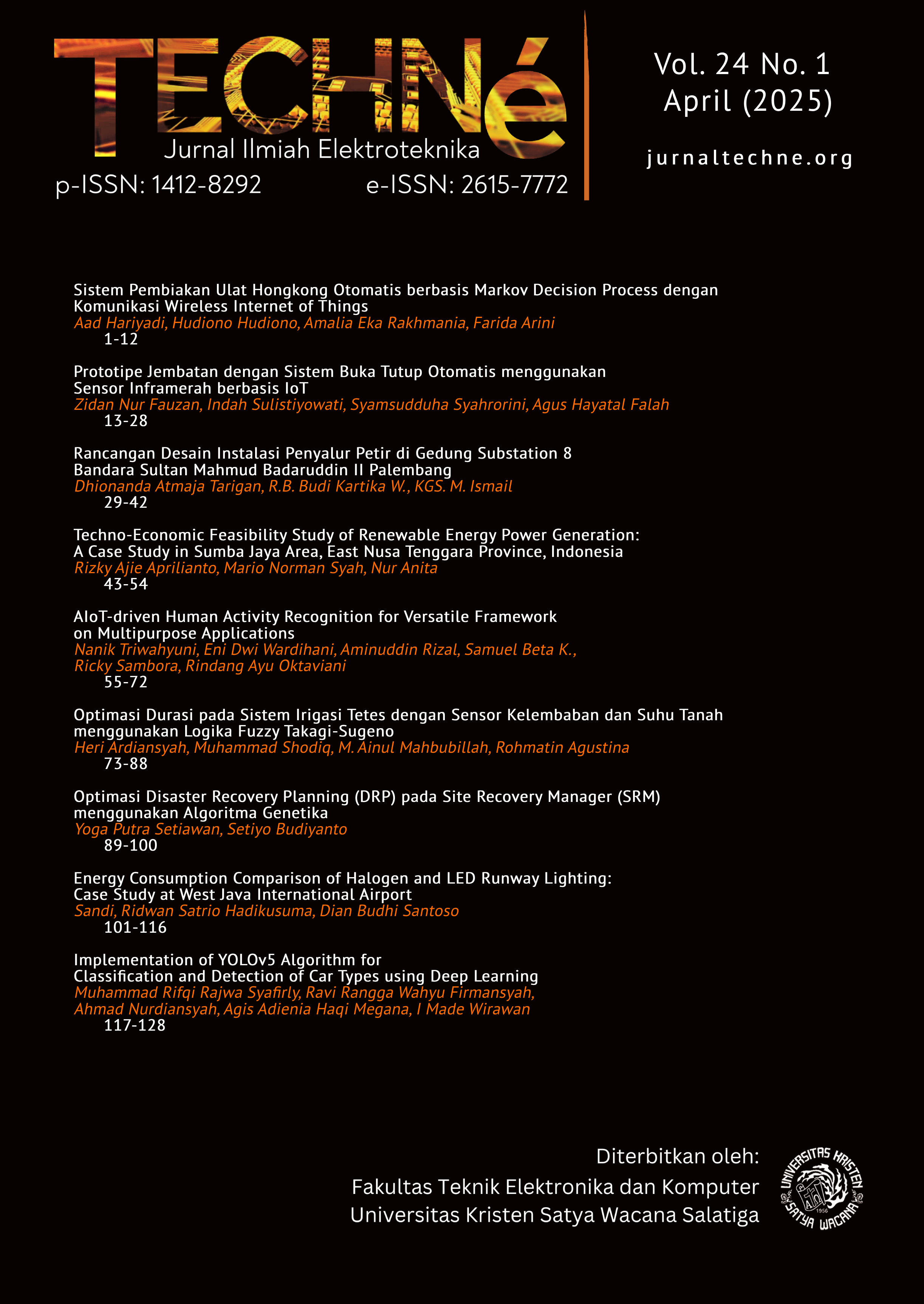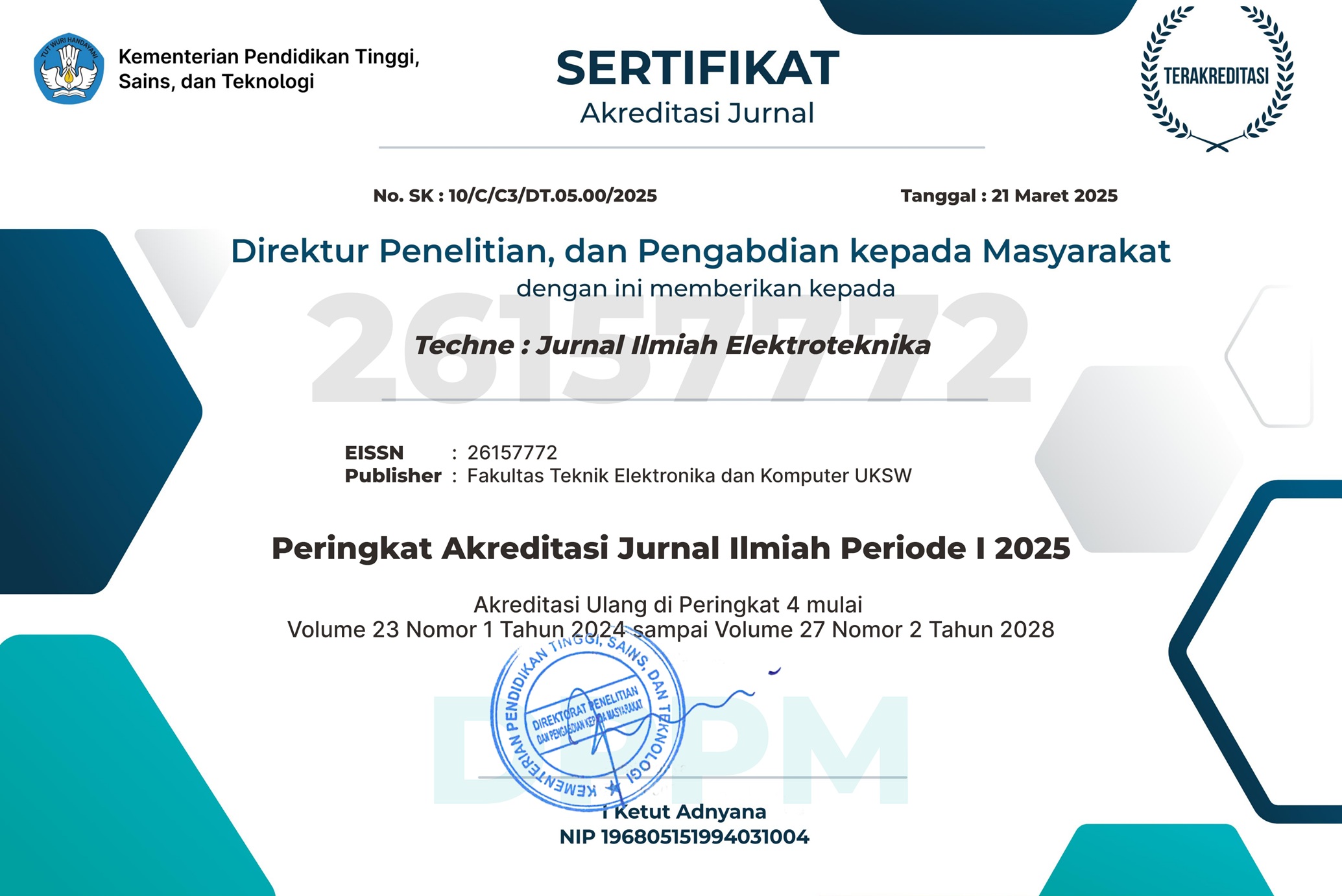AIoT-Driven Human Activity Recognition for Versatile Framework on Multipurpose Applications
DOI:
https://doi.org/10.31358/techne.v24i1.514Keywords:
artificial intelligence internet of things (AIoT), embedded device, human activity recognition (HAR), signal processingAbstract
This paper presents the implementation of an AIoT-based Human Activity Recognition (HAR) framework designed for multipurpose applications. The framework integrates sensor data from wearable IoT devices, which is then processed by AI algorithms to classify and predict human activities in real-time. It utilizes machine learning models, particularly machine learning techniques, to analyze complex activity. Our framework uses all open-source IDEs, which is able to replicate and modify. For this paper we give examples of how to use our framework as gamification of a workout practice. The Idea is to recognize user activity including (bicep curl, shoulder press, and front rise) using accelerometer data, and then send recognized activity to our developed online game (pop-balloon). M5StickC Plus used as the hardware which already equipped with IMU sensor and power management. Furthermore, it has small form factor fit for wearable application. Before real-time performance was taken, we evaluated 5 different machine learning model and choose which one is more optimized. The five models include Naïve Bayes, Support Vector Machine (SVM), AdaBoost, ZeroR, and Random Forest. Accuracy given for offline analysis were 97.68%, 98.97%, 41.62%, 25%, 100% respectively to the previous model. In the final, for real-time performance we choose SVM model which most optimized even though the accuracy reduced to 89.67% for this task.
Downloads
References
M. Chen and A. Sinha, "AIoT: When artificial intelligence meets the Internet of Things," Future Generation Computer Systems, vol. 95, pp. 718-721, Jun. 2019.
X. Sun, K. Zheng, L. Yang, and Y. Peng, "AIoT: AI meets IoT in 5G era," IEEE Communications Magazine, vol. 57, no. 10, pp. 41-47, Oct. 2019.
O. D. Lara and M. A. Labrador, "A survey on human activity recognition using wearable sensors," IEEE Communications Surveys & Tutorials, vol. 15, no. 3, pp. 1192-1209, 2013.
A. Bulling, U. Blanke, and B. Schiele, "A tutorial on human activity recognition using body-worn inertial sensors," ACM Computing Surveys, vol. 46, no. 3, pp. 1-33, Jan. 2014.
L. Wang, L. Yang, Z. Chen, and D. Zhao, "Human activity recognition with user-free sensors: From action to context," IEEE Access, vol. 7, pp. 23249-23271, Feb. 2019.
E. Casilari, J. A. Santoyo-Ramón, and J. M. Cano-García, "Analysis of public datasets for wearable fall detection systems," Sensors, vol. 17, no. 7, pp. 1513, Jul. 2017.
Y. Yuan, Z. Ding, W. Zhang, W. Zeng, and X. Zhao, "Personalized activity recognition with distribution calibrations," in Proc. AAAI Conf. Artif. Intell., vol. 33, no. 01, 2019, pp. 9121-9128.
MY. Chen, Y. Wang, Z. Xue, W. Zhang, and L. Zhang, "Human activity recognition with deep learning: A survey," IEEE Access, vol. 7, pp. 130,535-130,550, 2019.
O. Banos, M. Damas, H. Pomares, A. Prieto, and I. Rojas, "Daily living activity recognition based on statistical feature quality group selection," Expert Systems with Applications, vol. 39, no. 9, pp. 8013-8021, Jul. 2012.
B. K. Atzori, A. M. Fadda, A. Puiatti, and A. Sau, "Multi-sensor system for human activity recognition: Scalable and adaptive classification architecture," IEEE Sensors Journal, vol. 18, no. 23, pp. 9654-9661, Dec. 2018.
Q. Xia, S. Huang, H. Luo, J. Liu, and Z. Zheng, "AIoT: AI meets IoT in smart home applications," IEEE Internet of Things Journal, vol. 8, no. 15, pp. 12055-12066, Aug. 2021.
Z. Zhou, X. Chen, E. Li, L. Zeng, K. Luo, and J. Zhang, "Edge intelligence: Paving the last mile of AI with edge computing," Proceedings of the IEEE, vol. 107, no. 8, pp. 1738-1762, Aug. 2019.
S. Li, L. D. Xu, and S. Zhao, "The Internet of Things: A survey," Information Systems Frontiers, vol. 17, no. 2, pp. 243-259, Apr. 2015.
S. R. Das, S. M. U. Hasan, J. J. P. C. Rodrigues, L. A. Albuquerque, and S. Kozlov, "A survey on Internet of Things-based solutions for human activity recognition with a focus on energy efficiency," IEEE Internet of Things Journal, vol. 8, no. 12, pp. 9644-9657, Jun. 2021.
L. M. Dang, K. Min, H. Wang, M. J. Piran, C. H. Lee, and H. Moon, "Sensor-based and vision-based human activity recognition: A comprehensive survey," Pattern Recognition, vol. 108, p. 107561, 2020, doi: 10.1016/j.patcog.2020.107561.
Z. Wang, et al., "Challenges in Human Activity Recognition Using Wearable Sensors and Smart IoT Systems: A Review," IEEE Internet of Things Journal, vol. 7, no. 10, pp. 9258-9275, Oct. 2020, doi: 10.1109/JIOT.2020.3005396.
A. Rizal, "Tahapan Desain dan Implementasi Model Machine Learning untuk Sistem Tertanam," Ultima Computing: Jurnal Sistem Komputer, vol. 12, no. 2, pp. 79-85, 2020.
EasyEDA, "EasyEDA - Online PCB Design & Circuit Simulator," in EasyEDA, Version 6.4.19, EasyEDA Ltd., Shenzen, China, 2024. [Online]. Available: https://easyeda.com.
Arduino, "Arduino IDE," in Arduino Software (IDE), Version 2.1.0, Arduino LLC, 2024. [Online]. Available: https://www.arduino.cc/en/software.
Processing Foundation, "Processing IDE," in Processing, Version 4.2, Processing Foundation, 2024. [Online]. Available: https://processing.org.
J. Doe and A. Smith, "Comparison of Time-Domain and Frequency-Domain Features in Machine Learning for Signal Processing," IEEE Transactions on Signal Processing, vol. 68, no. 5, pp. 1234-1245, May 2024.
M. Hall, E. Frank, G. Holmes, B. Pfahringer, P. Reutemann, and I. H. Witten, "The WEKA Data Mining Software: An Update," SIGKDD Explorations, vol. 11, no. 1, pp. 10-18, 2009. [Online]. Available: https://www.cs.waikato.ac.nz/ml/weka/.
M5Stack, "M5StickC Plus 2 Data Sheet," Accessed: Aug. 18, 2024. [Online]. Available: https://docs.m5stack.com/#/en/core/m5stickc_plus.
H. Liang, "Weka4P: Weka Machine Learning for Processing," GitHub repository, [Online]. Available: https://github.com/howieliang/weka4P. Accessed: Aug. 18, 2024.
R. Chouta, "Sketch with p5.js," p5.js Editor. Available: https://editor.p5js.org/rajaschouta/sketches/rfRTRnJgt. Accessed on: Aug. 20, 2024.
I. H. Witten, E. Frank, and M. A. Hall, Data Mining: Practical Machine Learning Tools and Techniques, 3rd ed. Burlington, MA, USA: Morgan Kaufmann, 2011, pp. 102-103.
Y. Ding, H. Zhu, R. Chen, and R. Li, "An Efficient AdaBoost Algorithm with the Multiple Thresholds Classification," Appl. Sci., vol. 12, no. 12, pp. 5872, Jun. 2022. Available: https://www.mdpi.com/2076-3417/12/12/5872.
H. P. He, B. Li, X. Liu, J. Chen, and Y. Ma, "An empirical study on software defect prediction with a simplified metric set," Information and Software Technology, vol. 59, pp. 170–190, 2015.
Downloads
Published
How to Cite
Issue
Section
License
Copyright (c) 2025 Nanik Triwahyuni, Eni Wardihani, Aminuddin Rizal, Samuel Beta, Ricky Sambora, Rindang Oktaviani

This work is licensed under a Creative Commons Attribution-NonCommercial-ShareAlike 4.0 International License.








